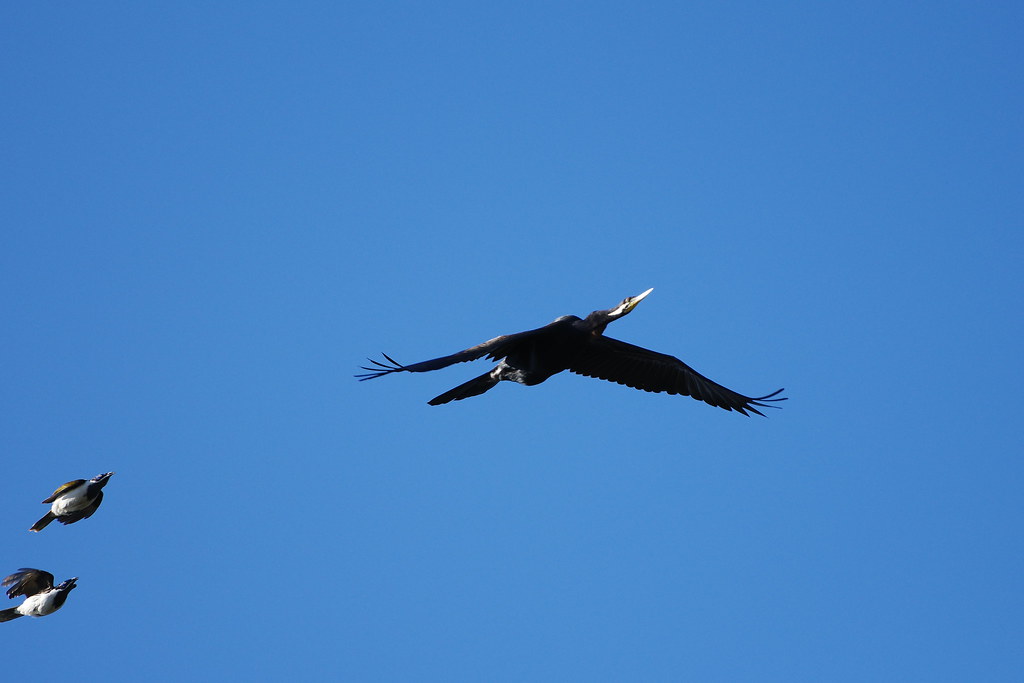I have a lot more hours now under my belt with camera, 150-450, and continuous focus. After this past weekend's BiF shots I think I'm beginning to get a handle on it, but still a work in progress.
When a bird/critter is at rest focus is essentially a non-issue. Pick up the camera, back-button focus and shutter. Takes just a couple of seconds and focus is
almost always spot-on, emphasis "almost always" with cluttered background and similar color tones.
Now with continuous focus I'm sure the regulars have seen my series where I concentrate on anticipating a moment when the bird takes flight or lunges for prey, or begins fights. Using TAv and small select zone I'll frame the subject and hold the focus button, snapping shutter as soon as movement is obvious. For lateral and close-in that works very well, not too challenging anymore, and I'm very comfortable that it works. Same even if a flying bird is moving at an angle to me in a clear sky. But I've had issues with birds moving towards or away from me, combined with more cluttered backgrounds, where the focus will shift to a background element before righting itself (if it's going to) after two or three frames.
I think I'm leaning now towards using shorter bursts, three shots was my go-to Saturday and Sunday, then refocusing before continuing with the tracking and more short bursts. That seemed to result in more keepers than just holding the focus and running off a long continuous burst. There were times the camera never did catch back up or took too many frames to do so, and pausing and resetting focus appeared to work better.
Of course with a diving eagle or osprey going for a fish those short bursts aren't ideal. I got some great nicely focused shots from diving through hitting the water on Sunday, but as soon as he splashed down I lost focus and didn't reestablish for a few frames after he got back in the air. That was with continually holding the focus button and yes after I think four frames later it caught back up. Water action seems to give the camera problems. When I have another opportunity I'm going to try stopping at the point the bird hits the water to reset focus and then restart the bursts to see it that's more successful. And BTW, medium burst seems to work well. Faster might work even better. Or not. But then there's not much working time before the buffer fills. That said I may also give fast burst a try if I'm limiting myself to 3-5 shots before pausing a second or two to refocus anyway.
By the way, owning the K3III and a pro-quality long lens has presented me with challenges I'd never accepted with my other cameras. I've so rarely used continuous shooting up until a few weeks ago it wasn't at all a consideration for me. One shot at a time, focus/shutter/focus/shutter. Yup I got fast with it too, but not fast enough to capture a heron first stalking then snatching a minnow from the water and lifting it up to eat, or the launch and flight of a Great Blue from his perch.
I bought the 150-450 in mid-March this year, and since then have put in roughly 40 hours shooting with it in combo with the K3III and most of the time in continuous. Gosh, it's been a learning experience. It's taken several weekends of at-dawn hikes thru the marshes and preserves to get comfortable with it, and another several to get to the point I'm understanding it. I feel I'm now progressing past a few somewhat lucky shots to expectations of success. I'm moving forward.

My joy found in wildlife photography is restored after a couple of years of lost interest in it.
Last edited by gatorguy; 05-10-2022 at 06:45 PM.


 Similar Threads
Similar Threads 



 My joy found in wildlife photography is restored after a couple of years of lost interest in it.
My joy found in wildlife photography is restored after a couple of years of lost interest in it.






















 Post #1 by Kobie
Post #1 by Kobie








